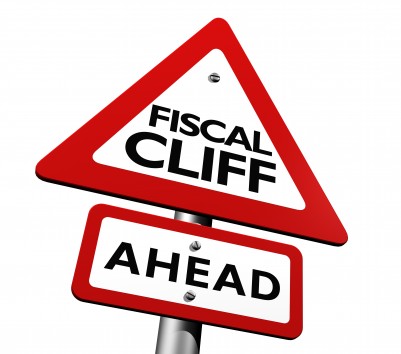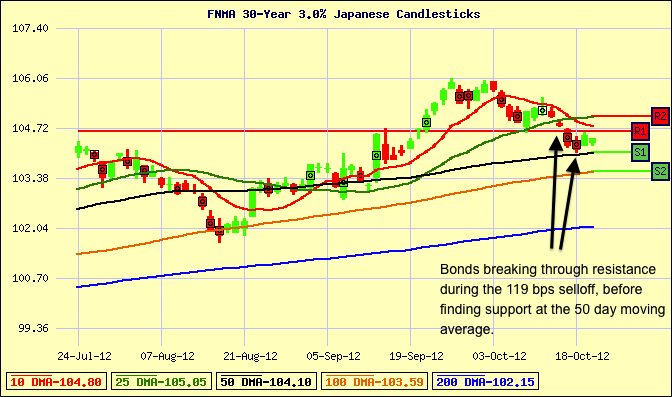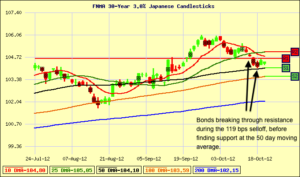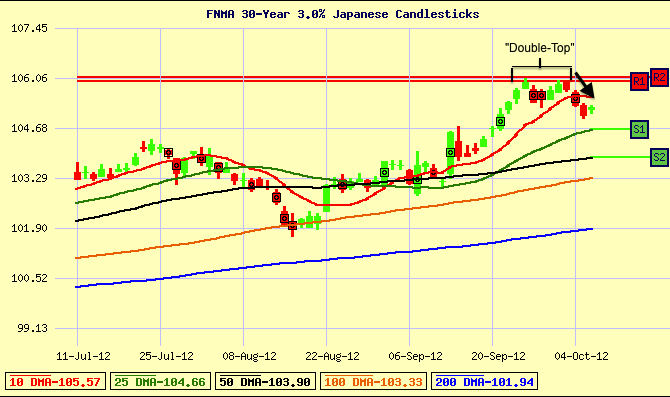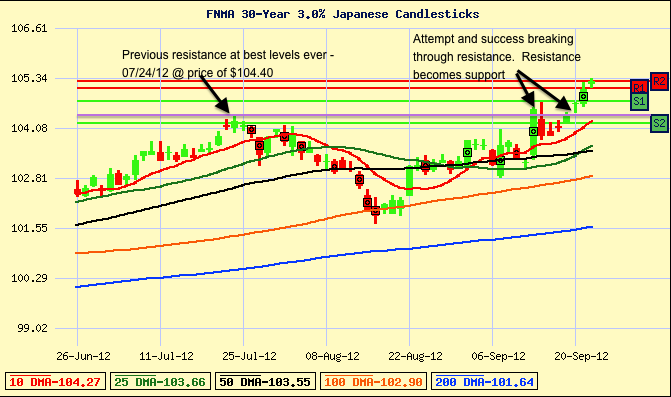Dallas Home Prices and Mortgage Rates on the Rise
Dallas, Texas home prices are on the rise as the market transitions from a home buyer’s market into a home s eller’s market. With droves of new buyers and move up buyers looking for homes in the area, the market is showing serious signs of a lack of inventory. All the while, home loan rates have moved up to their highest levels in over a year. Is time running out to buy a home at record low home prices and interest rates?
eller’s market. With droves of new buyers and move up buyers looking for homes in the area, the market is showing serious signs of a lack of inventory. All the while, home loan rates have moved up to their highest levels in over a year. Is time running out to buy a home at record low home prices and interest rates?
Dallas home prices have risen just over 7% in the last year, according to the S&P Dow Jones Indices, and are projected to keep rising. Some particular Dallas areas like Lakewood, Canyon Creek, Prestonwood, and University Park have seen close to double digit growth in the first quarter of 2013 alone. Home prices aren’t the only thing on the rise though, since mid-April, home loan rates for an average 30-year mortgage have increased from around 3.3% to 4%, just in the last 45 days. Although mortgage rates are driven by many factors and market conditions, mortgage rates are expected to continue going up with more positive economic data and more money flowing into Stocks.
The economy as a whole has had a rough past few years, but has recently been showing serious signs of growth and improvement. This kind of positive economic outlook, combined with a growing real estate market, continue to paint a bright future of the U.S. economy and housing market, particularly in Dallas and surrounding markets. Job growth from local companies as well as many large corporations relocating their company offices and headquarters, have continued to flow into the Dallas area. The continued population and job growth in the area is ultimately causing housing prices to continue increasing as any new supply is taken away by the new buyers in the area.
With home loan rates and home prices on the rise, now may be the time you’ve been waiting for to sell your home and buy another. For many other who are deciding to stay in their home, this may be their last chance to refinance before interest rates go back up to 5% or higher. Regardless of the path for your real estate future, consider the Cost of Waiting to Buy.
If you would like to find out more information about homes in the Dallas, Texas area, as well as the surrounding suburbs like Richardson, Prestonwood, Lakewood, University Park and Highland Park, please don’t hesitate to call us directly at 972-499-0454. We’ve helped thousands of Dallas-area homeowners and home buyers navigate their home purchase or refinance and we’d love to assist you. Contact us today!
Mortgage Rate and Real Estate Update – Week of 12/17/12
Tired of hearing about the fiscal cliff and quantitative easing (QE)? Me too. However, there are some key things on the table in Congress that may affect the house that you own or are thinking about buying.
- Is now the time to sell your home in the Dallas-Fort Worth area?
- Blogs writing blues got you down? Find out how to be a curator of content and have a surplus of topics for the New year
- Zig Ziglar – Life lessons from a ‘big brother’ and mentor
Fiscal Cliff and the Impact on Mortgage Rates and Deductions
Another week has passed without resolution to the ‘fiscal cliff’ that is ahead of us. In short, the ‘fiscal cliff’, a term coined by Fed Chief Bernanke, describes a massive shortfall in revenues (taxes) in comparison to the budget. Last year, Congress spent $3.6 trillion and only brought in $2.3 trillion in revenue, a shortfall of over 56%. If a family were to budget their finances in the same manner, they may have earned $100k in income for the year but ended up spending every dime they earned, saved zero dollars and would have racked up over $56,000 in additional credit card debt. No bueno, especially when the spending has been that way for years and years. Sorry U.S. government, no home loan for you!
So with a $1.3 trillion shortfall going forward, cuts must be made to the budget and tax revenues must be increased. Easy targets could be things like Homeland security, Energy or the Interior budget (No, not home furnishing for the White House), but these items are so small and would only account for less than 2.5% of the overall budget. The cuts will have to come from bigger components, things like Social Security, Health and Human Services, or Defense, each of which is held close to the heart of one of the powers in Congress, whether the Defense for the GOP or social programs for the Dems. Therein lies the stalemate so far. Two ways of thought and two ways of spending that must reach a common ground.
However, regardless of where the cuts come from, the Tax revenues will have to be increased. One sure way will be to raise taxes for those considered to be the ‘wealthiest Americans’, but the definition of those ‘wealthiest Americans’ is vastly different between party lines. Republicans have acknowledged these Americans to be earning $1 million and higher where the President stands behind his definition as those earning upwards of $250k. Whatever the collective definition ends up becoming, there will be additional tax revenue to help reduce the shortfall.
Aside from tax hikes for the wealthy, additional revenues will likely come from the elimination of certain tax deductions. The one near and dear to our hearts is the mortgage interest tax deduction, which currently allows owners of a primary residence to deduct the interest that they pay each year from their overall income, thus reducing their tax liability. Millions of American families are able to apply this deduction to their taxes each year and save on average $5,459 on their tax bill. Will this cause a slowdown for housing as home buyers see less incentive to buy instead of rent?
Other tax deduction caps are likely to come into the fold, possibly placing a cap on the total deductions that someone can take. For most individuals, the caps will be a non-issue, but for self-employed and small business owners, the caps will change the way their businesses and accounting practices are structured.
The Fed Introduces More Easing to Keep Rates Low
Amidst the talks of the fiscal cliff, the Fed held is closed-door meetings last week and announced its Fed Policy Change on Wednesday 12/12/12. Fed Chairman Bernanke announced that the Fed will begin spending an additional $45 billion per month, targeting longer term Treasury securities, replacing ‘Operation Twist’ which expires at year-end. The big twist came when the Fed decided to no longer use a specific timetable to indicate an end to the monetary policy. Instead the Fed has decided that they will not start tightening monetary policy until unemployment hits 6.5% and/or inflation between 1 and 2 years ahead is projected to be no more than one half percentage point above the committee’s 2% threshold and longer term inflation figures continue to be well anchored. The good news is that this shift in policy now allows the markets to make their own projections about when these thresholds will be reached and can adjust their trading and investment strategies accordingly.
The Fed’s Monetary Policy and How it Can Impact Mortgage Rates
Fed Chairman Bernanke announced that the Fed will continue their threshold to spend $40 billion per month targeting Mortgage Backed Securities, reiterating the early message that improvement in the housing market through a low-rate environment will be most effective path to improve the economy. The big change comes in the decision to start changing monetary policy (heavily through interest rates) once inflation is projected to be 2.5% or higher over the next 1 or 2 years. Since inflation has a direct relationship with mortgage interest rates, it’s highly probable that once projected inflation reaches/exceeds those levels, interest rates will go up. The Fed will do all in its power to keep inflation with a target range. How does the Fed control inflation? They increase interest rates that they allow Banks to borrow money, which increases the rates that Banks have to charge to their clients.
Ahem… (raises hand). Is it possible that all of the printing of money to be able to spend the $85 billion on mortgage and long term securities possible a risk for higher inflation and higher interest rates?
Fed’s likely response: We have yet to be able to determine the efficacy of the quantitative easement.
Down the rabbit hole we go. Let’s just go ahead and pretend that printing $1 trillion a year is a cause for higher inflation….just pretending though.
If the projected inflation triggers the Fed to change its monetary policy, the Fed would immediately start to increase interest rates as a way to combat inflationary pressures and reduce the supply of money in the market (make it cost more to borrow). The end result is that the interest rates for consumers start to go up until the Fed sees inflation readings get back into the target range of 1.8% – 2%. By that time, investors around the globe are starting say, “Wait a minute, you’ve sold me these securities on long-term mortgage and other things and they’re paying me a rate of return of 1.5%-2% but based on projected inflation, my dollar is going to be losing 3% or more per year? So I’ll be losing money? No thanks, I’m out.”
So what happens, investors sell their long-term securities and the only way to entice them back into the market is to….that’s right, Raise the rate or yield that they are receiving on that security. In other words, we have to raise mortgage rates to a level that still gives investors a way to outpace inflation and make money.
The days of a 30 year fixed rate in the 3% – 4% range could be long gone, trending back to a level of normalcy of who knows, 6% or 7%? Only time will tell. Food for thought – if interest rates go up by one percent, a buyer looking in the $250,000 price range will have lost $30,000 in purchasing power. If interest rates go up to 6% (last seen less than 5 years ago), the same budget would only allow a $175,000 loan amount. That’s a difference of $75,000 in purchasing power. It’s time to start thinking seriously about your home buying and/or home selling strategy.
Our Strategy for Home Loan Interest Rates Going Forward
Home loan rates continue to trade near historic lows and should continue to stay in its trading range for the coming weeks and possibly months. At the same time, we do not see any reason that interest rates should get much lower than they are now, so if you are waiting around for a 2% rate on a 30 yr, we wish you the best of luck. If it were me, I would take advantage of interest rates sooner rather than later. While the Fed maintains its goal of keeping home loan rates low for the foreseeable future, the Fed cannot control the entire market. The $40 billion a month being used to target mortgage backed securities can help support the market, but overall market direction is based on many bigger picture items (ie. inflation, strength of global economy, Credit ratings, etc.).
Historically, interest rates tend to be lower in the winter and creep higher during the peak home buying season in the spring and through summer. We expect this trend to continue but will remain proactive with our clients and their home loan strategy. If you’re happy with your home loan options, take them while you can. Whether in 2013 or 2014, we are potentially only one bad inflation reading away from higher interest rates.
We maintain an ongoing dialogue with our clients about the market and interest rates throughout their financing experience so we can take advantage of the lowest rates when they present themselves. We all want the lowest rate, and the best way to ensure that you get the lowest rate, is to build a relationship with your mortgage planner, so they can best advise you on when to lock in your rate. Call us today for a complimentary mortgage review or Apply Online.
Mortgage Rate and Real Estate Update – Week of 12/03/12
No deal yet on the Fiscal Cliff and we know you’re getting tired of hearing about it. However, home ownership is a big part of the plan. Find out if home mortgage deductions are going away and how other news from the Fiscal Cliff talks will likely drive home loan interest rates for the coming weeks.
- Real Estate Investors – The $9.2 Billion Impact of 28.1 million U.S. Real Estate Investors
- How Fannie, Freddie, and Congress will use Home Mortgages to Fund Expanded Visa Program?
- Next Generation Buyers: Gen X and Gen Y Home Buyers are Savvy, Sophisticated and Ready to Buy
Mortgage interest rate and real estate news from last week:
Talks of the fiscal cliff issues continue to dominate the newswires and the mindsets of traders. The past week has seen mortgage backed securities hold strong near historic lows and above the 50 day moving average. The volatility picked up last Tuesday as progress was reported surrounding the fiscal cliff issues. The positive rumored news immediately helped Stocks rally over 200 points, taking the wind out of the sails of mortgage backed securities. This was just a glimpse of how big of an impact the fiscal cliff news will be going forward. The good news for home loan rates came when they were able to hold on to support at the 50 day-moving-average, proving this level to be a very strong floor of support and a benchmark worse-case scenario for the near-term.
What’s coming up this week on the economic calendar and what’s the impact on interest rates?
All eyes and ears will continue to be on news coming from the Fiscal Cliff talks. It’s all a matter of raising revenues and reducing costs, unfortunately for homeowners and prospective home buyers, eliminating the mortgage interest tax deduction would be a major source of tax revenue. If any changes are made to the tax deductions of mortgage interest, they are likely to be phased out over many years.
With the fiscal cliff talks ongoing, the economic calendar is full of employment and jobs data. Starting on Wednesday with the release of the ADP National Employment Report and rounding out with the Jobs Report on Friday, there is little ‘good’ news expected. Given the impact of storms on the East coast, there will likely be an increase in the Unemployment Rate and Initial jobless claims.
Here’s our strategy for the days and weeks ahead…
As home loan rates hover near historic lows and above support at the 25 and 50 day moving average, home loan rates are not expected to make a large move in either direction. As trading slows into the holiday season, any volatility that would drive home loan rates is likely to come from the fiscal cliff talks. We will recommend to cautiously float interest rates in the near term. However, should Congress find a resolution and back away from the cliff, expect the volatility to resurface at the possible expense of an increase in mortgage rates.
We maintain an ongoing dialogue with our clients about the market and interest rates throughout their financing experience so we can take advantage of the lowest rates when they present themselves. We all want the lowest rate, and the best way to ensure that you get the lowest rate, is to build a relationship with your mortgage planner, so they can best advise you on when to lock in your rate. Call us today for a complimentary mortgage review or Apply Online.
Mortgage Rate and Real Estate Update – Week of 11/26/12
It’s not a cyber Monday sale, home loan rates have actually been this low for a while now. Thanks to the fiscal cliff issues and Eurozone drama being front and center, interest rates are holding strong near historic lows.
Mortgage interest rate and real estate news from last week:
- Low mortgage rates allow buyers to afford up to 20% more in home price compared to 3 years ago
- The Fall and Rise of Jumbos – Homes values with jumbo mortgages fell hard, now rising Fast
- “G-Fees” drive up loan costs across the board for some states – Texas lucky to avoid this round, for now…
- Holiday tidbit – Wanting your own ’12 Days of Christmas’? The cost this year tops $107k
In a holiday shortened trading week, home loan interest rates and mortgage bonds were mostly unchanged. News that Europe is now in the midst of its second recession in four years and the U.S. weekly jobless claims coming it at their highest level in 18 months would typically spark more volatility, but interest rates seem to be comfortable in the current trading range established over the last month near historic lows. The low volume trading and friendly Bond news allows the Fed to keep their QE3 stimulus funds available for any major volatility that may come to the markets.
What’s coming up this week on the economic calendar and what’s the impact on interest rates?
With no major economic reports due for release this week, most attention will be placed on talks of a lawmakers reaching a resolution on the fiscal cliff issues. The markets will also be closely watching a meeting of finance ministers in the Eurozone as they digest news of the recession. The battle grows deeper as major Euro countries like Germany, refuse to participate in further “bail-outs” of Greece unless they can make further budget cuts and commit to repay some of their debt.
In the midst of the global economic soap opera, the Treasury will be auctioning off $99 Billion in Notes this week. Depending on the investor appetite of the 2, 5, and 7 year Note auctions, we could see volatility creep back into the Bond markets. On the flip side, should the auction go well, the S&P 500 could slip further from its 200 day moving average, allowing home loan rates to move closer to all time lows.
Here’s our strategy for the days and weeks ahead…
Interest rates for home loans have found a comfortable trading range over the last 30 days and have managed to create a solid level of support just beneath current levels. As long as mortgage Bonds can manage to remain above this key technical support, interest rates have a great chance to rally and move closer to all time lows for interest rates. Our advice would be to float in the near term unless something changes, causing pricing to break through support. With the amazingly low interest rates available to homeowners and home buyers, the time is now to consider their options for a refinance or start their planning for a home purchase.
We maintain an ongoing dialogue with our clients about the market and interest rates throughout their financing experience so we can take advantage of the lowest rates when they present themselves. We all want the lowest rate, and the best way to ensure that you get the lowest rate, is to build a relationship with your mortgage planner, so they can best advise you on when to lock in your rate. Call us today for a complimentary mortgage review or Apply Online.
Mortgage Rate and Real Estate Update – Week of 10/29/12
NYSE closed and Bond Markets closing early with Hurricane Sandy bearing down on the Northeast. Zillow launches its “Foreclosure Center” for prospective home buyers.
Mortgage interest rate and real estate news from last week:
- Zillow reports that U.S. home values saw their largest gain since 2006 with values jumping 1.3 percent in the third quarter
- Zillow launches its “Foreclosure Center” to give prospective home buyers access to pre-foreclosures, foreclosures and auctions in their area – http://www.zillow.com/foreclosures/
- Fed policy statement hints of continued slow growth with QE3 bond buying until the U.S. economy can support itself
- Third quarter GDP grew compared to the second quarter. Increased home buying helped fuel the growth
- Japan launches stimulus of $9.4 billion to increase growth and avoid “the risk of a Japanese fiscal cliff”
- Bank of America’s $4 billion purchase of Countrywide costs B of A more than $40 billion after write-downs, legal expenses, and settlements
What’s coming up this week on the economic calendar and what’s the impact on interest rates?
With the Bond Markets closing early on Monday in the wake of Hurricane Sandy, prices of mortgage backed securities opened higher but light trading is expected until the storm passes. SIFMA, who oversees the Bond markets, has announced that Bond markets will also be closed on Tuesday.
Core PCE was released upon market opening on Monday and showed a slight increase, a signal that inflation is starting to creep into the picture. However, the Fed still maintains a stance that inflation is not a concern. Halloween on Wednesday could prove to be a spooky trading day as investors hope to be back in action after a weather induced trading hiatus.
Weighing heavy on their trading direction will be the ADP Employment Report, Employment Cost Index and Chicago PMI, all scheduled for release on Wednesday morning. The reports continue on Thursday with Initial Jobless Claims and the national manufacturing index, ISM. ISM measures expansion or contraction in national manufacturing with a number over 50 signaling expansion and a number below 50 signaling contraction. The week closes with the Friday morning release of a highly anticipated Jobs Report. Having shown signs of growth and lower unemployment, more of the same is expected for the last Jobs Report before the election.
Here’s our strategy for the days and weeks ahead…
Bond prices and home loan rates won’t see much activity over the coming days, but we will be on guard when the markets reopen on Wednesday. With a heavy dose of Bond impacting news and shorter window to accomplish their Bond purchasing for the week, we could see home loan rates make an attempt to get back to their best levels ever. We will be watching the market reports closely throughout the week. Should pricing fall below current levels of support, we will recommend locking.
We maintain an ongoing dialogue with our clients about the market and interest rates throughout their financing experience so we can take advantage of the lowest rates when they present themselves. We all want the lowest rate, and the best way to ensure that you get the lowest rate, is to build a relationship with your mortgage planner, so they can best advise you on when to lock in your rate. Call us today for a complimentary mortgage review or Apply Online.
Current Mortgage Interest Rates – Week of 10/22/12
Mortgage interest rates increase by a quarter percent with selling pressure proving to be too much for Fed’s QE3 purchasing power. Nearly $100 billion in Treasury auctions, 3rd quarter GDP, and a FOMC meeting likely to make an impact on rates going forward.
What happened with mortgage interest rates last week?
Mortgage backed securities had one of their worst trading weeks in over 2 months, losing nearly 120 basis points before seeing a slight rebound on Friday. The selling pressure pushed mortgage bonds beneath support before finding resistance at the 50 day moving average. The move caused interest rates to increase by nearly .25%, providing another glimpseof how selling pressure can outweigh the Fed’s QE3 buying power.
The bond selling was largely influenced by economic releases and market news that began after the major inflation reading, Core CPI, was reported higher than expected. Not so great news for the first major inflation reading following the launch of QE3. Additionally, housing starts in September increased by 15% and Moody’s reported that they would maintain Spains debt rating. Positive economic news and higher than expected inflation is a recipe for Stock buying and Bond selling.
Further selling pressures are coming from an influx of new mortgage originations. As the low rates continue to increase home purchase loan and refinance activity, the added volume will continue to test the Fed’s QE3 purchasing power for months to come.
What’s coming up this week on the economic calendar and what’s the impact on interest rates?
The economic calendar is light this week with no major economic reports due other than a reading on third quarter Gross Domestic Product (GDP) on Friday. The biggest news of the week will come with the Fed’s monetary policy statement on Wednesday at 11:30 am CT. The statement will follow the two-day Federal Open Market Committee (FOMC) meeting. While there are no major changes expected to the Fed Funds Rate or the QE3 mortgage backed security purchase program of $40 billion per month, traders and investors will be analyzing the statement line by line to make notice of any changes.
Also on the radar this week will be the Treasury auction of $99 billion in two, five, and seven year Treasury notes. The added supply will give more options to investors and could sway purchasers away from mortgage Bonds until they establish further support on the 50 day moving average.
Here’s our strategy for the days and weeks ahead…
Following the large sell off in mortgage backed securities, Mortgage Bonds should technically hold on to current support at the 50 day moving average. For clients that were not able to lock in their rate last week before the market moved, we are recommending they float into the FOMC meeting, anticipating that pricing can rebound after being oversold. Should the market start to push Bonds below support, we will immediately shift to a Locking stance. The next level of support is over 100 basis points lower and would translate to higher interest rates.
We maintain an ongoing dialogue with our clients about the market and interest rates throughout their financing experience so we can take advantage of the lowest rates when they present themselves. We all want the lowest rate, and the best way to ensure that you get the lowest rate, is to build a relationship with your mortgage planner, so they can best advise you on when to lock in your rate. Call us today for a complimentary mortgage review or Apply Online.
Current Mortgage Interest Rates – Week of 10/15/12
Home loan rates stabilize in a new trading range after a 4 day sell off. Despite tame inflation and QE3 Bond buying, interest rates fail to recover back to historic lows. With a new trading trend emerging and a full week of economic releases, find out why you may need to lock in your interest rate before Friday.
What happened with mortgage interest rates last week?
Mortgage backed securities end the week roughly where it started, failing to break through resistance and re-establish a trading territory at the best levels for mortgage rates. After opening the week lower and dropping for the 4th day in a row, mortgage bonds found support at the 25 day moving average.
Weekly Initial Jobless Claims were reported at their lowest level since 2008. This encouraging news came after a report earlier this month that showed the Unemployment Rate dropped to its lowest level since early 2009. Both reports show promise for employment, but may be a brief blip on the radar amongst a trend of otherwise stagnant growth.
The Mortgage Bonds continued to trend higher on Friday morning after the Core PPI came in within the Fed’s target range. Core PPI is a wholesale inflation reading that will act as a barometer for the Fed and their ability continue stimulus and maintain a low rate environment.
It’s worth noting that Bonds have run out of steam the last 3 Fridays, causing rates to see a brief move higher. With the Fed only purchasing a set amount of Bonds per week, once those allotted funds are gone, the Bond trading will be handled without interference in the open market. When that’s happened to this point, Bonds have suffered.
What’s coming up this week on the economic calendar and what’s the impact on interest rates?
The economic calendar this week is packed with important data that could have an impact on Stocks and Bonds. The inflation readings will start with tomorrow’s (10/16) release of the Consumer Price Index (CPI). While the Core PPI released last week was tame, the CPI will be the first major inflation gauge since the Fed started into their QE3 printing/spending.
The economic reports continue on Wednesday with a projected increase in housing starts and building permits. While the reading may not have a large impact on Bond prices, the reports are worth noting as we move further into the week. Thursday will feature the release of more labor data with Initial Jobless Claims at 7:30 CT. Most attention from bond traders will be placed on the Philly Fed Index at 9am CT. The manufacturing report can have an impact on Stocks and Bonds as it helps forecast the upcoming release of the ISM Index.
Here’s our strategy for the days and weeks ahead…
With Bonds trading near support at the 25 day moving average, we are recommending our clients carefully float the market. The support can help provide a worst-case-scenario with an opportunity to lock in the rate if pricing breaks through the resistance level. However, Bonds are still trading near historic lows and the Fed has yet to show that their QE3 purchasing power has the ability to drive rates much lower. Given that rates have suffered at the end of the last 3 weeks, our sentiment may shift towards a locking bias if Bonds fail to make any substantial move in our favor.
We maintain an ongoing dialogue with our clients about the market and interest rates throughout their financing experience so we can take advantage of the lowest rates when they present themselves. We all want the lowest rate, and the best way to ensure that you get the lowest rate, is to build a relationship with your mortgage planner, so they can best advise you on when to lock in your rate. Call us today for a complimentary mortgage review or Apply Online.
Current Mortgage Interest Rates – Week of 10/9/12
Mortgage bonds reach their peak for a second straight week but fail to set new records. PIMCO bond fund manager and co-founder warns bonds could be “burned to a crisp”.
What happened with interest rates last week?
Mortgage bonds peaked at the best levels in history for the second straight week, signaling a new ceiling of resistance for bonds, with investors less willing to buy at historic levels. With mortgage interest rates still at or near historic lows, the Fed is accomplishing its goal of keeping rates low through the QE3 bond buying.
The economic news was light last week, leading up to Friday’s Jobs Report, where the Labor Department reported 114,000 new jobs in September and a falling Unemployment Rate of 7.8%. Both figures showed signs that the labor market is starting to see some level of improvement.
Positive headlines out of Europe led to investor selling pressures earlier in the week, but the Fed quickly stepped in to purchase the added supply. Further selling pressure came as Bill Gross, the manager of the world’s biggest bond fund with over $1.8 trillion in assets under management, warned that bonds could be “burned to a crisp” if the U.S. doesn’t tackle its debt problems. He further warns that if the U.S. does not change its fiscal direction, we jeopardize the U.S. Treasury and mortgage bonds’ status as the world’s go-to safe haven, in addition to the dollar’s role as the world’s premier reserve currency. This says a lot from a guy whose fund made $2.8 billion in cash last month from their Bond activity.
What’s coming up this week on the economic calendar and what’s the impact on interest rates?
The market was closed on Monday in observance of Columbus Day. Bond prices opened the week higher on Tuesday, following a report from the International Monetary Fund (IMF), stating that the world economy will grow by 3.3% this year, the slowest since 2009. News that’s bad for economic growth, but good for safe-haven bond buying and interest rates.
On the economic calendar, the activity will be light until Thursday at 9:30 CT when Initial Jobless Claims are released. Although the release shouldn’t have a big impact on mortgage interest rates, we will watch closely to gauge any growth in the employment sector. Also weighing on Bonds this week will be a $32 Billion 3-Year Note auction on Tuesday 10/9.
Having peaked at the same resistance levels and pulled back each of th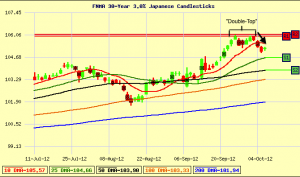 e last two weeks. From a technical standpoint, a “Double Top” has formed, signaling a short-term bearish signal. This technical signal appears when mortgage bonds have a rise, a drop, another rise of the same level, and another drop. Instead of breaking through the ceiling of resistance, the Bonds have been pushed lower at the resistance each time. After multiple attempts, odds are not good that the level will be broken in the near term.
e last two weeks. From a technical standpoint, a “Double Top” has formed, signaling a short-term bearish signal. This technical signal appears when mortgage bonds have a rise, a drop, another rise of the same level, and another drop. Instead of breaking through the ceiling of resistance, the Bonds have been pushed lower at the resistance each time. After multiple attempts, odds are not good that the level will be broken in the near term.
Here’s our strategy for the days and weeks ahead…
Having attempted to break through and set new historic lows, mortgage backed securities have seen pretty steep sell-off since the end of last week. While we do expect interest rates to maintain their current trading range, I feel that the opportunity to buy a new home or refinance your current home at the lowest rates in history will not be around for long. That could be weeks, could be months, but the opportunity will not be around for years. If you’ve thought about selling and buying a home, it’s time to create a game plan.
The Fed will continue its Bond buying through QE3, maybe even a QE4, 5, 6…. But, we tend to agree with Mr. Gross and his PIMCO billions. The man understands the Bond market and has brought up a valid point that ties together our fiscal direction and the value of our U.S. Bonds and Dollars. As a “safe-haven” for the fearful global investor, we don’t realize how their safety-seeking investing has helped keep our markets afloat with their influx of capital. If the sentiment ever turns to our Dollar and Bonds not being a “safe-haven”, we could see bonds, rates, and our dollar suffer greatly.
Our clients that we have closing in the near term are advised to float their interest rate to see if Bonds can make another run at their historic levels. After a several week, upward trend, we will be switching our stance to a locking bias if selling pressures cause Bond prices to suffer. Longer term transactions occurring in the next few weeks to months, we recommend starting your approval process now to be in a position to lock in your rate when the opportunity arises.
We maintain an ongoing dialogue with our clients about the market and interest rates throughout their financing experience so we can take advantage of the lowest rates when they present themselves. We all want the lowest rate, and the best way to ensure that you get the lowest rate, is to build a relationship with your mortgage planner, so they can best advise you on when to lock in your rate. Call us today for a complimentary mortgage review or Apply Online.
Current Interest Rates – Week of 10/1/12
Stocks suffer their worst weekly loss in over a year. Home loan interest rates reach their lowest levels ever, but where can they go from here?
What happened with interest rates last week?
The stock market finally ran out of steam last week as the worst weekly loss since last June was handed to investors. Fortunately for home buyers and someone thinking about refinancing, as stocks are sold, investors will often shift their money to mortgage bonds and drive our mortgage rates lower.
Mortgage backed securities put on quite a show as they rocketed to new historic highs as the expense of the stock sell-off. The rally did fizzle as the week came to an end. In part due to a research report from Nomura Research, indicating that now is a time to take profits in Mortgage Bonds and adopt a more neutral stance. If this advise is followed, the mortgage bonds will lose in price with the investor profit-taking, driving home loan rates higher.
The disconnect between the state of our economy and stock prices has continued to grow. In large part due to a varying difference in philosophies between our government and business owners. Many major corporations have spent the last few years cutting back expenses in an attempt to sustain during the times of recession and economic uncertainty. The fears of slowing growth and lack of conviction in a political direction have made companies reluctant to grow and hire new employees. The end result is companies effectively managing their cash flow and creating a surplus of cash, allowing the payment of dividends and the hope of minimized downside risk. On the other hand, our economy and government as a whole (both parties), are continuing in a direction of increased spending through economic stimulus, and employment growth through government jobs. The end result here is yet to be seen, but the deficit continues to climb and massive amounts of cash only seem to appear in the form of stimulus. Which philosophy do you think is working?
What’s coming up this week on the economic calendar and what’s the impact on interest rates?
The economic calendar is light this week leading up to the Non-farm payrolls report on Friday. The majority of pressure on mortgage bonds and home loan rates will stem from reactions to Fed news and commentary throughout the week. Wednesday will feature the release of the FOMC Minutes. We already know that QE3 was the main topic in the last meeting, but the minutes could highlight some key points and opinions from the Fed members. Particularly after Charles Plosser, President of the Federal Reserve Bank of Philadelphia, said he doesn’t think that QE3 will be effective and that competing philosophies are dividing the Fed members.
Investors in stocks and bond markets will also be monitoring political unrest in Europe as Spain and Greece digest new austerity measures that may spawn violent protests. Any unrest could be a catalyst for investors to seek the safe haven of our bonds.
Here’s our strategy for the days and weeks ahead…
With mortgage backed securities sitting at the best levels in history and mortgage interest rates extremely low, the Fed is achieving their goal. There’s little reason to think that home loan rates will move significantly lower.
In the near term, we would expect that home loan rates would trend higher before going lower. The Fed has their stimulus spending gun loaded to keep rates low, but as we started to see late last week, when supply starts hitting the market (bond sellers), there has to be a buyer on the other end (Fed) to keep the price from deteriorating. Once the supply outweighs the purchasing power, the bond prices will drop and rates will go up. To protect against this, we continue to recommend locking in rates at historic lows.
We maintain an ongoing dialogue with our clients about the market and interest rates throughout their financing experience so we can take advantage of the lowest rates when they present themselves. We all want the lowest rate, and the best way to ensure that you get the lowest rate, is to build a relationship with your mortgage planner, so they can best advise you on when to lock in your rate. Call us today for a complimentary mortgage review or Apply Online.
Current Interest Rates – Week of 9/24/12
Mortgage backed securities continue to paint the record books with the help of QE3 and the Fed’s attempt to further stimulate the economy. Find out why Robert Shiller from the Case/Shiller Home Price Index says that he feels that mortgage interest rates will not fall much further from their current levels. Is this the best rates are going to get?
What happened with interest rates last week?
Home loan interest rates managed to find their way back to all time lows last week as the Bond markets started their rally based on weak economic data out of Asia and Europe and the continued Bond buying from the Fed and the QE3 stimulus. The Fed is currently purchasing $40 billion of mortgage backed securities each month and could not have ho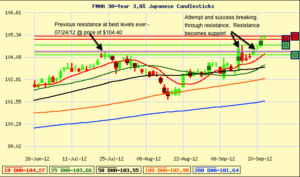 ped for better results in the first full week of the stimulus. Mortgage backed securities have risen by over 125 basis points, leading to our lowest interest rates ever. Aside from the weak economic data out of Asia and Europe, Initial Jobless Claims came in higher than expected at a number of 382,000.
ped for better results in the first full week of the stimulus. Mortgage backed securities have risen by over 125 basis points, leading to our lowest interest rates ever. Aside from the weak economic data out of Asia and Europe, Initial Jobless Claims came in higher than expected at a number of 382,000.
From a technical standpoint, we’re painting a new picture going forward. Mortgage backed securities have broken through all previous resistance levels established back on July 24th, 2012, our previous all time highs. As a result of breaking through resistance, these levels now will act as a floor of support, highlighting a new “worst case” pricing for home loans closing in the near term.
What’s coming up this week on the economic calendar and what’s the impact on interest rates?
The economic calendar is packed with releases this week. Starting on Tuesday with the Case-Shiller Home Price Index and Consumer Confidence, New Home Sales on Wednesday and Initial Jobless Claims on Thursday, the markets should continue their current trend leading into the big news on Friday. The Friday reports will start off with the Core Personal Consumption Expenditures, the Fed’s favorite gauge of inflation, which measures price changes in consumer goods and services after excluding food and energy components. Since inflation has a direct impact on interest rates, the report will be monitored to see if the year-over-year inflation figure has increased from its previous level of 1.6%. Also schedule for release on Friday is the Chicago PMI. Also known as the “Business Barometer”, the Chicago PMI is a manufacturing report indicating what may be to come in the ISM survey that will be released the following business day.
Here’s our strategy for the days and weeks ahead…
The stage is set for home loan rates to drop to the lowest levels we may see in our lifetime. Mortgage backed securities have broken through nearly all resistance levels, weak economic news continues to flow out of Europe and Asia, QE3 is in full swing. What more could we ask for?
Robert Schiller of the Case-Schiller Home Index expects that mortgage rates will not fall much further from their current levels. Here are a few reasons why:
- High Loan Volume = Higher Rates – The home purchase markets are continuing to gain traction as home prices stabilize and interest rates set historic lows. Throw in the numerous refinance programs available to current home owners and you’ll find lenders across the board are as busy as they have been in years. When loan volume increases and lenders start to reach capacity, they reach a breaking point. Beware of the bigger Banks like Wells Fargo, Chase, Bank of America, Citi, etc. Turn times are likely to get extended to a point that the applications are not able to close for 60-90+ days. As a result, their interest rates may be adjusted higher to slow down incoming applications. Smaller Banks and lending institutions (ie. Brazos National Bank) can avoid some of these issues with streamlined underwriting and closing processes.
- “G-Fee” – The “g-fee” or Guarantee fee has been implemented twice in the past 12 months and is a charge on all Fannie Mae and Freddie Mac home loans. The fee equates to roughly 75 basis points in price adjustment and is designed to raise revenues for Fannie/Freddie in an attempt to privatize the government sponsored entities. The previous “g-fee” was announced less than 3 weeks ago, and is now being followed by a third round of “g-fees”, targeting New York, Florida, Connecticut, New Jersey and Illinois. Follow the link to read FHFAs notice.
As the Guarantee fees mandated by FHFA continue to accrue and big Banks run at max capacity, the QE3 stimulus can only do so much to drive down home loan rates. A disconnect will start to form between the price of mortgage backed securities and the actual home loan interest rates that are offered to consumers.
Home loan rates have never been this low and may not stay this low for long. We are advising our clients to lock in their interest rate in the near term to take advantage of today’s low rates. In the longer term, we may see rates go lower, but there are too many other factors that can’t be solved by money printing (QE3), that are likely to send rates higher.
We maintain an ongoing dialogue with our clients about the market and interest rates throughout their financing experience so we can take advantage of the lowest rates when they present themselves. We all want the lowest rate, and the best way to ensure that you get the lowest rate, is to build a relationship with your mortgage planner, so they can best advise you on when to lock in your rate. Call us today for a complimentary mortgage review or Apply Online.

